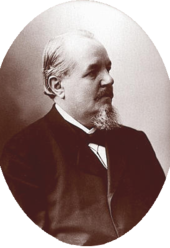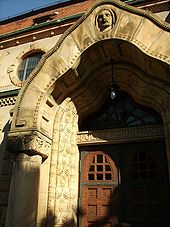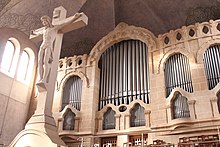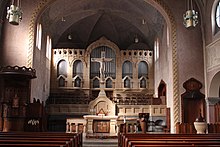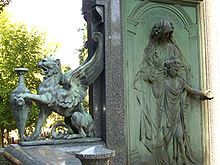Markuskirche (Stuttgart)
The Markuskirche is a Protestant church in the Stuttgart district south on Filderstraße, at the corner of Römerstraße, in the Heusteigviertel . It is used by the Evangelical Markus Congregation as a parish church. The Fangelsbach cemetery borders the church .
Building history
When the population of Stuttgart grew rapidly towards the end of the 19th century and the city and the surrounding villages began to grow together, the Markus Congregation was founded from parts of the Leonhard, Paul and Heslach congregations. At first it only had a makeshift church at the cemetery on Heusteigstrasse. The Württemberg church architect Heinrich Dolmetsch was commissioned to plan the new church . The foundation stone was laid on July 8, 1906. On March 29, 1908, the church named after the evangelist Markus was consecrated in the presence of King Wilhelm II . As one of the first places of worship to be made of reinforced concrete , St. Mark's Church is of great importance for sacred buildings in the 20th century. It remained almost undamaged in World War II . An extensive restoration took place from 1976 to 1978.
layout
The church is built in Art Nouveau style, which can be seen as an exception for sacred buildings in Germany. It is a three-aisled hall church in plastered masonry, with the comparatively low aisles appearing more like adjoining rooms, so that overall the character of a hall church with a uniform nave exists. The side-mounted tower (48.5 m high) is one of the world's first church towers made of reinforced concrete, but the nave is also made of this building material. Since the concrete has been completely plastered, this cannot be seen by looking at it. The curved dome of the tower has a late Baroque design language, which changes from the square floor plan into the octagon and finally into the round. Romanesque elements are predominantly found on the exterior, for example the columns at the main portal, the arched windows, the friezes. A golden lion appears above the western gable of the nave as a symbol of the evangelist Mark.
The interior is - apart from the subordinate aisles - a uniform hall, which is spanned by a barrel vault with cassettes. Inside, the columns can again be viewed as Romanesque , while the coffered barrel vault connects to the Renaissance . Between the arches and the large circular windows of the clerestory are relief friezes inserted with scenes from the Gospel of Mark. The Art Nouveau influence is primarily present in the furnishings and ornamentation , starting with the Christ head above the main portal and the decorative forms of the portal frames , then through the door fittings, the colored glass of the door panels, the partly still existing original lamps, the banisters, and the Furniture in the sacristy. The pulpit inlays by Rudolf Yelin the Elder are from the interior. Ä. and the altar decorations in craft leather with wood inlay are remarkable. The organ's prospectus is the only one north of the Alps made of stone. The position of the organ and the singing gallery behind the altar is exceptional.
organ
The instrument was built in 1908 by the organ builder EF Walcker & Cie. built. In 1935 the organ was expanded and rearranged by Walcker in the neo-baroque style. In 1955 the instrument was expanded again; the window that was originally visible in the middle of the prospectus was covered by a 16 'row of pipes. In 1969 the organ building company Steinmeyer redesigned the instrument and switched from cone chests to electropneumatic slide chests. The organ work today comprises 60 registers (in 1908 there were 53) on three manual works and pedal. The playing and stop actions are electro-pneumatic.
|
|
|
|
|||||||||||||||||||||||||||||||||||||||||||||||||||||||||||||||||||||||||||||||||||||||||||||||||||||||||||||||||||||||||||||||||||||||||||||||||||||||||||||||||||||||||||||||||||||||||||||||||||||||||||||||||
- Coupling : II / I, III / I, III / II, I / P, II / P, III / P (also as super octave coupling); II / II,
- Playing aids: setter system, tutti, crescendo roller, coupling individually from the roller, individual tongue storage
Stuttgart confession of guilt
The Markuskirche gained historical importance through the Stuttgart confession of guilt in October 1945. It was prepared by a sermon by Niemoller in the Markuskirche. The head of the ecumenical delegation Willem Adolf Visser 't Hooft recalled this in his autobiography:
“When we arrived in the largely destroyed Stuttgart, we heard that a special service would take place in the Markuskirche that evening, with Bishop Wurm , Pastor Niemöller and Bishop Dibelius to speak. Niemöller preached about Jeremiah 14: 7-11: “Oh Lord, our iniquities deserve it; but help for your name's sake! ”It was a powerful sermon. Niemöller said that it is not enough to blame the Nazis, the church must also confess its guilt. "
The Stuttgart confession of guilt arose as the fruit of this evening service . It was placed in front of the representatives of the ecumenical movement on the morning of October 19, 1945 and handed over to them - probably in the house at Eugenstrasse 22, which was then available to the collegiate parish. In the Markuskirche there is a memorial plaque with his full wording. The claim that the confession of guilt was handed over to the community there is a legend.
Fangelsbach cemetery
The Fangelsbachfriedhof was created in 1823 as a replacement for the closed Leonhardsfriedhof and the hospital cemetery that was still in use. It is one of the most important historical cemeteries in Stuttgart. Personalities such as the master builder Nikolaus von Thouret , the manufacturer Gustav Siegle , the director of the Royal Cabinet of Natural Products Oscar Fraas and Carl von Schiller, Friedrich Schiller's son , are buried here. In the park-like grounds, you can admire classical angels and magnificent graves of wealthy citizens.
literature
- Ellen Pietrus: The new church buildings by Heinrich Dolmetsch - An architect in the Kingdom of Württemberg ; in: Reutlinger Geschichtsblätter, New Series No. 40, year 2001, ed. Stadtarchiv Reutlingen and Reutlinger Geschichtsverein, 2001, pp. 125–228
- Ellen Pietrus: Church furnishings by Heinrich Dolmetsch: how to deal with room settings in the late 19th and early 20th centuries. In: Preservation of monuments in Baden-Württemberg. 5, 2005, ISSN 0342-0027 , pp. 88-99.
- Ellen Pietrus: The Markus Church in Stuttgart. Deutscher Kunstverlag, Munich et al. 2007, ISBN 978-3-422-02035-1 ( DKV edition ).
- Willem A. Visser 't Hooft: The world was my church. Autobiography. 2nd Edition. Piper, Munich et al. 1974, ISBN 3-492-01973-0 .
- Norbert Bongartz: "New Style" and Art Nouveau. For the restoration of the Protestant St. Mark's Church in Stuttgart . In: Denkmalpflege in Baden-Württemberg , 7th year 1978, issue 1, pp. 1–7 - available at [1] , last accessed on April 5, 2019
Web links
Individual evidence
Coordinates: 48 ° 45 ′ 52.6 " N , 9 ° 10 ′ 27.1" E

